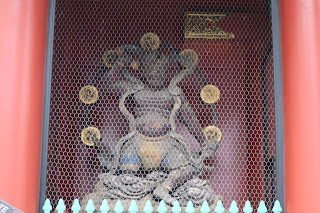Senso-ji (officially Kinryu-zan Senso-ji, also known as Asakusa Kannon), is an
ancient Buddhist temple located in Asakusa, Tokyo, Japan.
It is Tokyo's oldest temple, and one of its most significant. Formerly
associated with the Tendai sect of Buddhism, it became independent after World
War II.
It is dedicated to Kannon, the bodhisattva of compassion, and is the most
widely visited religious site in the world with over 30 million visitors
annually.
Adjacent to the temple is a five-story pagoda, the Asakusa Shinto shrine, as
well as many shops with traditional goods in the Nakamise-dori.
|
Thunder Gate (Kaminarimon).
The Thunder Gate (Kaminarimon) is the outer of two large entrance gates
that ultimately leads to the Senso-ji (the inner being the Hozomon) in
Asakusa, Tokyo, Japan.
-
The gate, with its lantern and statues, is popular with tourists.
-
It stands 11.7 metres (38 ft) tall, 11.4 metres (37 ft) wide and
covers an area of 69.3 square metres (746 sq ft).
-
The first gate was built in 941, but the current gate dates from 1960,
after the previous gate was destroyed in a fire in 1865.
|
|
Thunder Gate statues.
Four statues are housed in the Thunder Gate (Kaminarimon), two in the
front alcoves and two on the other side.
-
On the front of the gate, the statues of the Shinto gods Fujin and
Raijin are displayed.
-
Fujin, the god of wind, is located on the east side of the gate, while
Raijin, the god of thunder, is located on the west side. The original
sculptures were severely damaged in the fire of 1865, with only the
heads being saved, and the statues restored for the gate's 1960
reconstruction.
-
Two additional statues stand on the reverse of the gate: the Buddhist
god Tenryu on the east, and the goddess Kinryu on the west side. These
were donated in 1978 to commemorate the 1350th anniversary of the
first appearance of the bodhisattva Kannon (Avalokitesvara) at
Asakusa, which led to the founding of Senso-ji.
-
The statues were carved by then-106-year-old master sculptor Hirakushi
Denchu.
|
|
Treasure-House Gate (Hozomon).
The Treasure-House Gate (Hozomon) is the inner of two large entrance
gates that lead to the Senso-ji.
-
It is a two-story gate (nijumon), and its second story houses many of
the Senso-ji's treasures.
-
The first story houses two statues, three lanterns and two large
sandals. It stands 22.7 metres (74 ft) tall, 21 metres (69 ft) wide,
and 8 metres (26 ft) deep.
|
|
Two guardian statues.
Unlike the Thunder Gate (Kaminarimon), which houses four different
statues, the Treasure-House Gate (Hozomon) houses two guardian statues
that are located on either side of the gate's south face.
-
These 5.45 metres (17.9 ft) tall statues represent Nio, the guardian
deities of the Buddha.
-
Because of these statues, the gate was originally called the Nio Gate
(Niomon) before it was renamed the Treasure-House Gate (Hozomon).
|
|
Five-Storied Pagoda (Gojunoto).
|
|
Nakamise-dori Street.
Nakamise-Dori, the street leading from the Thunder Gate to the temple
itself, is lined with small shops selling souvenirs ranging from fans,
ukiyo-e (woodblock prints), kimono and other robes, Buddhist
scrolls, traditional sweets, t-shirts and mobile phone straps.
-
These shops themselves are part of a living tradition of selling to
pilgrims who walked to Senso-ji.
|
|
Purification Fountain (Chouzusha).
|
|
Senso-ji Temple.
The temple is dedicated to the bodhisattva Kannon (Avalokitesvara).
-
According to legend, a statue of the Kannon was found in the Sumida
River in 628 AD by two fishermen, brothers Hinokuma Hamanari and
Hinokuma Takenari. The chief of their village, Hajino Nakamoto,
recognized the sanctity of the statue and enshrined it by remodeling
his own house into a small temple in Asakusa so that the villagers
could worship Kannon.
-
The first temple was founded in 645 AD, which makes it the oldest
temple in Tokyo. In the early years of the Tokugawa shogunate,
Tokugawa Ieyasu designated Senso-ji as tutelary temple of the Tokugawa
clan.
-
During World War II, the temple was bombed and destroyed during the 10
March air raid on Tokyo. It was rebuilt later and is a symbol of
rebirth and peace to the Japanese people.
|
Asakusa Shrine
|
Large Stone Torii.
Asakusa Shrine (Asakusa-jinja) is a Shinto shrine located in the Asakusa
district of Tokyo, Japan.
-
Also known as Shrine of the Three gods (Sanja-sama), it is one of the
most famous Shinto shrines in the city.
- The shrine honors the three men who founded the Senso-ji.
-
It can be found on the east side of the Senso-ji down a street marked
by this large stone torii.
|
|
Asakusa Shrine.
An example of the gongen-zukuri style of architecture, Asakusa
Shrine was commissioned by Tokugawa Iemitsu and constructed in 1649
during Japan's Edo period.
-
Unlike many other structures in the area, including the Senso-ji, the
shrine (along with the Nitenmon) survived the Tokyo air raids of 1945.
-
See more at
Asakusa Shrine - Wikipedia.
|
Tokyo Skytree
|
Tokyo Skytree (Tokyo Sukaitsuri).
Tokyo Skytree (Tokyo Sukaitsurī), is a broadcasting and observation
tower in Sumida, Tokyo.
-
It became the tallest structure in Japan in 2010 and reached its full
height of 634 meters (2,080 ft) in March 2011, making it the tallest
tower in the world, displacing the Canton Tower, and the third tallest
structure in the world after the Merdeka 118 (678.9 m or 2,227 ft) and
the Burj Khalifa (829.8 m or 2,722 ft).
-
The tower is the primary television and radio broadcast site for the
Kanto region; the older Tokyo Tower no longer gives complete digital
terrestrial television broadcasting coverage because it is surrounded
by high-rise buildings.
-
Skytree was completed on Leap Day, 29 February 2012, with the tower
opening to the public on 22 May 2012.
-
See more at
Tokyo Skytree - Wikipedia.
|
See also
Source
Location






















